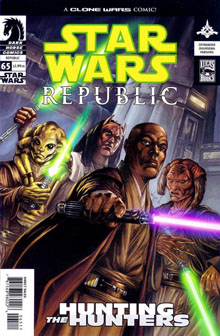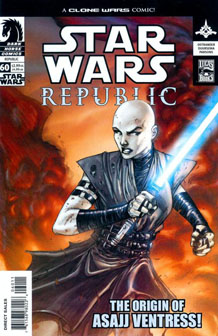The 2004 run of “Republic” marks some of the finest ongoing “Star Wars” storytelling. Primary writer John Ostrander balances his long-running Quinlan Vos saga – taking the shadow-dwelling Quinlan up to his return to the Jedi Order and keeping us guessing about his true loyalties – with treatises on the relationship between war and the loss of liberties.
Always respectful of what other writers are doing, Ostrander and secondary writer Haden Blackman synergize their continuity with the novels “Shatterpoint” (where Mace loses his friend, Depa Billaba, to a dark-side coma of sorts) and “Jedi Trial” (where Anakin becomes a Knight). Ostrander and Blackman establish the rivalry between Obi-Wan and Asajj Ventress, something that would go on to permeate the “Clone Wars” TV series. In late 2004, they also begin to pepper in new “Episode III” baddie General Grievous, who made his debut in the “Clone Wars” microseries in April 2004.
Synergy in “Star Wars” storytelling isn’t just about comics and novels coordinating with each other, or comics/novels incorporating film elements. Sometimes George Lucas was inspired by the Expanded Universe. As I noted in an earlier post, he brought Aayla Secura from “Republic” into “Episode II’s” Battle of Geonosis. A less-talked-about Lucas nod to the comics comes when Mace Windu, Kit Fisto, Saesee Tiin and Agen Kolar, who appear in a heroic pose on the cover of Issue 65 (“Show of Force, Part 1,” June 2004), team up again to take arrest Palpatine in “Episode III.”
(In one case of non-synergy, Dooku’s henchman Tol Skorr is NOT the same person as the bounty hunter Skorr from the Goodwin/Williamson strips. I looked it up on Wookieepedia to be sure.)

I noted in a previous post that “Show of Force” (65-66) was originally supposed to be a sixth “Jedi” issue, “Bariss Offee.” However, only the first few pages feature Bariss, then she hands the baton to Mace Windu, who proceeds with the other members of Team Mace from the cover image to take on a contractor who is accepting bounties on Jedi. If I have a complaint about the 2004 “Republic” comics, it’s that Ostrander and Blackman kick a lot of characters to the curb. Bariss and her Master Luminara Unduli, popular from the books and microseries, are barely used in the comics. And it seems that former “Republic” stars Aurra Sing, the Dark Woman, A’sharad Hett and Villie have ceded their page space to Quinlan, Obi-Wan, Anakin and Ventress.
“The Dreadnaughts of Rendili” (69-71) masterfully merges these four characters, especially in the final pages. In an informal trial before the Jedi Council, Quinlan defends his undercover actions from preceding issues. In “Striking from Shadows” (63), Quin kills Senator Viento, who he had assumed to be the second Sith Lord (as it turns out, he was merely a corrupt senator). In a nice bait-and-switch, Ostrander and artist Jan Duursema makes a reader think Vos is actually going after Sidious. Also, Vos injures respected Jedi Master K’Kruhk in the aftermath. In “Show of Force” (65-66), Quin kills the corrupt leader of Ryloth. In “Armor” (68), he flirts with the idea of killing Aayla in order to secure a biological weapons package for Dooku, but opts not to (which leads to his off-page banishment from Dooku’s team).

Quin defending himself before the Council is a much meatier version of the final “Clone Wars” Season 5 arc. Ahsoka’s story frustrated me because I dislike stories where smart people are swayed by a frame-job against someone they know well. With Quin, though, we (and the Jedi Council) honestly don’t know if he’s good or bad. Quin himself asks the Council “Have I let the dark side take me?” Quin’s monologue is beautifully interspersed with scenes of Anakin fighting Ventress to her (presumed) death. As one Jedi returns to the light (presumably), another Jedi descends into darkness, with a prescient Duursema drawing Anakin in his “Episode III” Evil Face, just minus the glowing yellow eyes.
Blackman takes the reins on the second major arc of this batch: Obi-Wan’s escape (along with clone Alpha) from Ventress’ clutches, with Anakin rescuing him in the end in “Hate and Fear” (60) and “No Man’s Land” (62). As Anakin tells his temporary master, Ki-Adi-Mundi, in Issue 62: “I don’t feel that Obi-Wan is dead! My feelings tell me Master Obi-Wan is still alive! And he needs me!” The Season 4 “Clone Wars” arc, where Obi-Wan fakes his death for the sake of an undercover mission, explores Obi-Wan and Anakin’s bond in the face of false information more thoroughly.
But these are still important issues, especially since Issue 60 tells Ventress’ origin story on perpetually war-torn Rattatak. A bad guy who looks a lot like (but isn’t) Riff Tamson, the shark-like baddie from the Mon Cala arc in “Clone Wars” Season 4, kills Ventress’ parents and later her Jedi Master. While she hates him (and gets her revenge in this story), she also hates the Jedi for not helping her and her master. Basically, Ventress is filled with hate and always needs a target for it. That’s not quite enough to explain why she loathes Obi-Wan specifically, but Obi-Wan takes Ventress’ master’s lightsaber at the end of this issue, so that at least gives her new material to center her rage on.
In a nice bit of accidental synergy, Ventress rides a rancor monster while fighting Obi-Wan on a destroyed scientific-expedition ship in “The Dreadnaughts of Rendili.” As fans know, the “Clone Wars” TV show re-wrote Asajj’s backstory so that she is a Dathomir Nightsister, and the first time we met Dathomir Nightsisters, in “The Courtship of Princess Leia” (1994), some of them ride rancors. Lucasfilm ret-conner extraordinaire Leland Chee synched up Ventress’ two backstories in an article in Star Wars Insider No. 122 (“Everything You Always Wanted to Know About the Nightsisters But Were Afraid to Ask”) so that Asajj was kidnapped from Dathomir and raised on Rattatak.
Ostrander also writes two think-pieces about politics and war in this batch. “Dead Ends” (61) shows us Bail Organa’s first steps toward becoming a strong anti-war, pro-Constitution (or the Republic equivalent) voice, with guest appearances from wrongly disgraced Chancellor Valorum and Mon Mothma. Bail’s speech to the Senate denouncing the Security and Enforcement Act (amidst yells of “Traitor!”) could be a Ron Paul speech:
“Some of the powers in this act were never intended to be given to the central government. They are rights that belong to the citizens and to which we do not have a claim.”
Written in reverse chronology, “Bloodlines” (64) is a more confusing read, but a nice companion piece to Issue 61 as it gives an example of how Palpatine has his political enemies killed.
If you want to wipe away those challenging wartime questions in exchange for a pure “nobility of war” soldier’s tale, Randy Stradley’s “Forever Young” (67) has you covered. You can probably guess the outcome from the title: A young master-less Padawan embarks on a suicide mission to blow up a Separatist droid factory, much to the chagrin of Anakin.
Some fans may dismiss Dark Horse’s original Clone Wars run as apocryphal after the emergence of the 2008 “Clone Wars” TV series, which in some cases contradicted Dark Horse’s work (Asajj’s backstory being a prime example). But the 2004 batch of comics shows that there’s still plenty of worthwhile stuff here, and the continuity can often be smoothed out, as Chee showed. And some of these yarns — notably, Quinlan’s story — are even better than the TV series.

